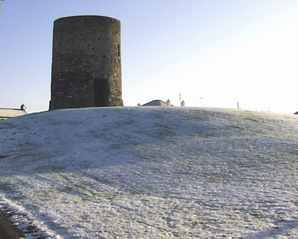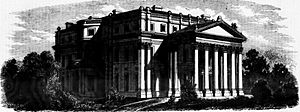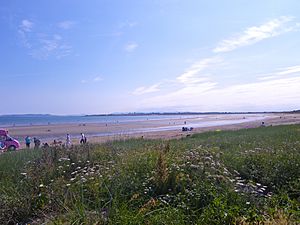Rush, Dublin facts for kids
Quick facts for kids
Rush
Irish: Ros Eó
|
|
|---|---|
|
Town
|
|
| An Ros | |

Millbank, a ruined windmill on Chapel Green
|
|
| Country | Ireland |
| Province | Leinster |
| County | County Dublin |
| Area | |
| • Total | 5.84 km2 (2.25 sq mi) |
| Elevation | 1 m (3 ft) |
| Population
(2022)
|
|
| • Total | 10,875 |
| Time zone | UTC±0 (WET) |
| • Summer (DST) | UTC+1 (IST) |
| Eircode routing key |
K56
|
| Telephone area code | +353(0)1 |
| Irish Grid Reference | O263543 |
| Historical population | ||
|---|---|---|
| Year | Pop. | ±% |
| 1821 | 1,044 | — |
| 1831 | 2,144 | +105.4% |
| 1841 | 1,603 | −25.2% |
| 1851 | 1,496 | −6.7% |
| 1861 | 1,453 | −2.9% |
| 1871 | 1,238 | −14.8% |
| 1881 | 1,071 | −13.5% |
| 1891 | 1,130 | +5.5% |
| 1901 | 1,076 | −4.8% |
| 1911 | 804 | −25.3% |
| 1926 | 1,540 | +91.5% |
| 1936 | 1,651 | +7.2% |
| 1946 | 1,747 | +5.8% |
| 1951 | 1,925 | +10.2% |
| 1956 | 2,007 | +4.3% |
| 1961 | 2,118 | +5.5% |
| 1966 | 2,488 | +17.5% |
| 1971 | 2,633 | +5.8% |
| 1981 | 3,864 | +46.8% |
| 1986 | 4,514 | +16.8% |
| 1991 | 4,839 | +7.2% |
| 1996 | 5,429 | +12.2% |
| 2002 | 6,769 | +24.7% |
| 2006 | 8,286 | +22.4% |
| 2011 | 9,231 | +11.4% |
| 2022 | 10,875 | +17.8% |
Rush is a lovely seaside town in Fingal, County Dublin, Ireland. Its official Irish name is An Ros. This name means "peninsula of the yew trees".
Rush is located on the coast of the Irish Sea. It sits between the towns of Skerries and Lusk. The town has a small harbour where boats can dock.
In the past, Rush was famous as the "market garden of Ireland". This was because growing vegetables and fruits was a very important part of its economy. Today, Rush is a growing commuter town. This means many people who live here travel to Dublin for work. In 2022, about 10,875 people lived in Rush.
Contents
Exploring Rush's Location
Rush is right on the Irish Sea coast. It's where the R128 road changes direction. This road connects Rush to Lusk and Skerries.
The area around Rush has some small hills near the sea. Four streams flow into the sea close to the town. These are St. Catherine's Stream, Kenure Stream, the Rush Town Stream, and another stream on the western side. Sometimes, these streams can cause minor flooding. The Rush Town Stream and Kenure Stream both cross Rush's North Strand beach.
Rush is also a specific area of land called a townland. It is part of the larger civil parish of Lusk.
A Look Back at Rush's History
People have lived in the Rush area for a very long time. Evidence shows settlements from the Neolithic period, which was the New Stone Age. Tools made of flint have been found here. There is also an ancient burial site called a passage grave and a cist (a stone box for burials) near the Skerries Road.
In the Middle Ages, Rush was owned by the Earl of Ormond.
In 1744, a visitor described Rush as a town about a mile long. Most houses were made of mud and straw. Many people lived there, and they mostly worked in fishing.
In November 1920, during a time of conflict, an Irish Republican Army (IRA) officer named John McCann was shot. His body was found nearby the next morning. Today, a monument on Quay Road remembers him.
Drumanagh: An Ancient Fort
There is a large ancient fort called a promontory fort at Drumanagh, close to Rush. It is surrounded by tall cliffs on three sides. A big wall, called a rampart, protects the fourth side.
In 1996, a newspaper article suggested that Roman coins and other Roman items were found here. It claimed there might have been a Roman fort. However, many archaeologists disagree. They believe these items show that Ireland traded with the Romans, not that Romans built a fort here. The items were found illegally, so they could not be studied properly.
Fingal County Council bought this land in 2016. It is very important because Roman-British items are rarely found in Ireland. It is thought that Roman traders might have landed here.
Recent digs at the site have found many interesting things. These include pieces of Roman pottery and two decorated Iron Age combs. Two fragments of human bone were also found. They are part of a female skull dating back to 170 BC to 52 AD.
Fingal County Council has created a plan to protect Drumanagh fort. This plan helps make sure the site's history and importance are preserved for the future.
Saint Maur's Churches
The remains of the first St. Maur's chapel are in Whitestown cemetery. This is about a mile west of Rush town centre. This chapel dates back to Anglo-Norman times. It is named after Saint Maurus, a follower of St. Benedict.
There is a story that French sailors were caught in a storm. They promised St. Maur that if they survived, they would build a chapel for him. They landed near Rogerstown and built the chapel there.
In 1776, a new church was built closer to Rush. It was also dedicated to St. Maur. This was one of the first Catholic churches built in the Fingal area after the Penal Laws were relaxed. This building is now Rush library.
The newest Catholic church of Saint Maur is next to the 1776 building. It was opened in 1989.
Kenure House: A Grand Estate
About two miles north of Rush village, you can see a grand portico. This is all that is left of Kenure House. This was once a huge mansion with many acres of land around it. The name "Kenure" comes from "Ceann Iubhair," meaning "headland of the yew trees." Nearby, there are ruins of an old church and a small Norman castle tower.
The portico was added to Kenure House around 1840 by an architect named George Papworth. Many films were made at this impressive house. These include The Face of Fu Manchu (1965) and Ten Little Indians (1965).
The house became old and damaged. It was taken down in 1978. A housing estate called Saint Catherines was built on part of the old estate. Some people in Rush tried to save the house. They managed to save the portico, which you can still see today.
Martello Towers: Defending the Coast
Rush has two of the 29 Martello Towers in the Greater Dublin Area. These towers are on the headland near the North Beach and at Drumanagh. They were built in 1804. Their purpose was to defend against a possible attack by Napoleon.
Fun Things to Do in Rush
Rush has two beautiful sandy beaches: the North Beach and South Beach. A rocky area and a small harbour separate them. The peninsula is the closest land point to the private Lambay Island.
Rush South Beach is a great place for kitesurfing because of the wind and tides. Its sand and dunes also attract many visitors. There is a 9-hole golf course close to the south shore. In the past, Rush had many caravan sites for summer holidays. Some caravan sites are still near the beaches.
The Rush Sailing Club is also near the south shore. It uses a second harbour called Rogerstown harbour. This harbour is also used by a boat called The Shamrock. This boat takes supplies to the people living on Lambay island.
Rush has several pubs, clubs, and a few restaurants. The local Millbank Theatre is home to the Rush Dramatic Society. They are known for their good plays. The Rush Musical Society also puts on great shows every year.
Schools in Rush
Rush has three primary schools for younger students:
- Gaelscoil Ros Eo
- Rush National School
- St. Catherines National School
There is also a secondary school for older students:
- St.Joseph's Secondary School
Getting Around Rush
The Rush and Lusk railway station opened in 1844. You can catch suburban trains here that travel between Dublin and Drogheda.
Fingal Express is a private bus service. It offers trips from Skerries, Rush, and Lusk to Dublin City Centre and UCD.
Sports in Rush
Rush is home to many sports clubs:
- Naomh Maur GAA club (Gaelic games)
- Rush Athletic F.C. (football)
- Rush Sailing Club
- Rush Cricket Club
- Elite Taekwon-Do Academy
- Rush Fight Academy
- Rush And Lusk Karate Club
Many famous athletes are from Rush. Stephen McPhail, a footballer for Shamrock Rovers and Ireland, played for Rush Athletic when he was young. David Worrell, a former Ireland U21 Captain, also played for Rush Athletic. Eoin Morgan, who became the captain of the England cricket team, grew up in Rush. He and his family played for Rush Cricket Club for many years.
Religion in Rush
Rush is a parish in the Roman Catholic Archdiocese of Dublin.
Famous People from Rush
- Isibeal Atkinson, Irish footballer
- Derek Landy, Irish author
- Stephen McPhail, Irish footballer
- Eoin Morgan, Irish cricketer
- David Worrell, Irish footballer
Sister Towns
Rush is connected with other towns around the world. This is called "twinning."
See also
 In Spanish: Rush (Irlanda) para niños
In Spanish: Rush (Irlanda) para niños





